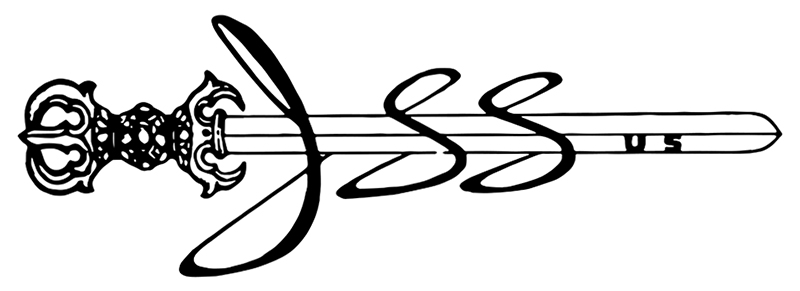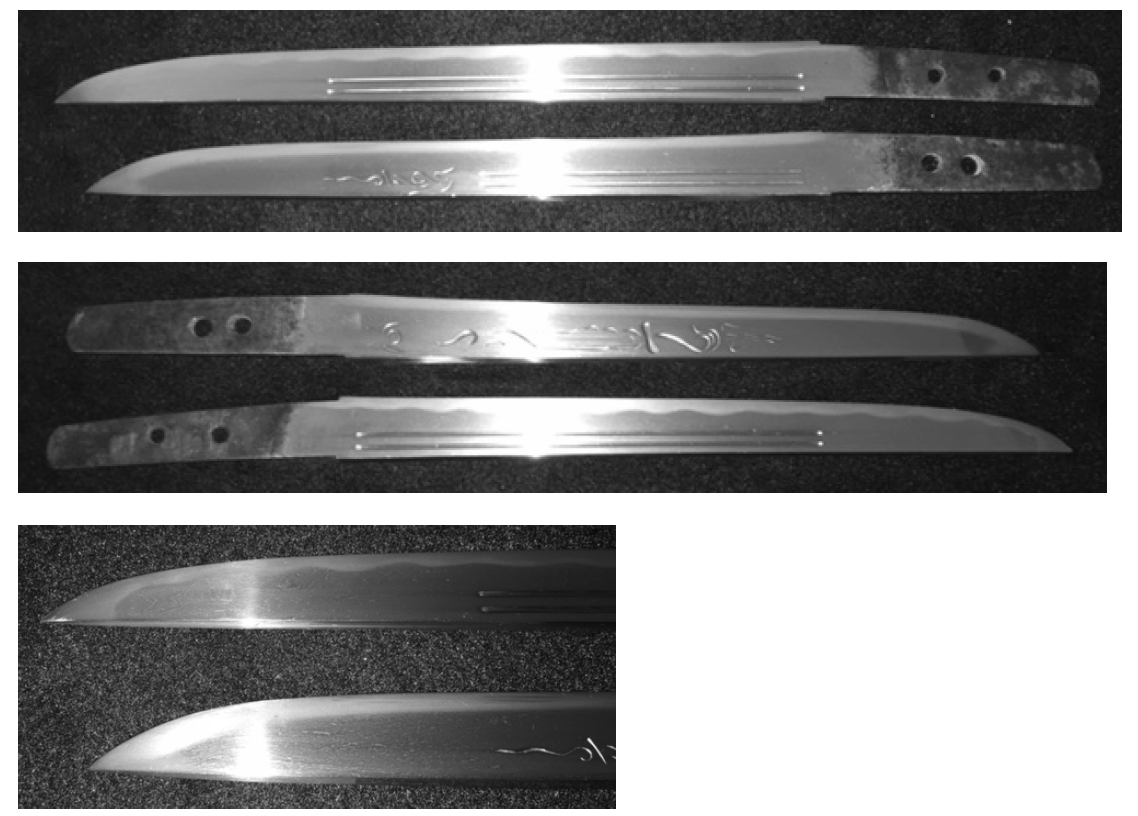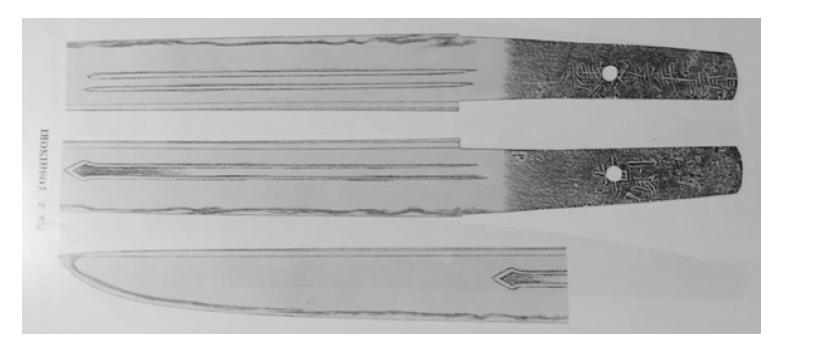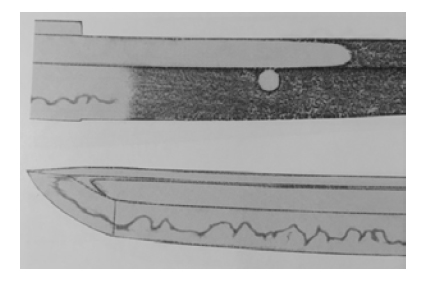
The articles on this page originally appeared in JSSUS newsletter Volume 48 no.3 2016.
Real -Life Kantei of swords , part 9: The History of Two Tanto – By W.B. Tanner and F.A. B. Coutinho Page 6
Copyright 2016 Japanese Sword Society of the United States
Real-Life Kantei of Swords, Part 9: The history of two tanto
W.B. Tanner and F.A.B. Coutinho
Introduction
Kantei is a complicated and often imprecise activity. Despite years of study, countless documents and handling of hundreds of swords, one will inevitably be faced with a sword which does not fit “with in the box” of known characteristics. We discussed this in our article about kantei of Oei Bizen swords, “Real-Life Kantei of swords -Part 8” where we examined examples of swords made in the same time period in the Bizen school and determined that they did not all fit easily into the “Oei Bizen Box”. There are numerous reasons why this is so, such as incomplete data, differences of opinions among “experts” throughout the years, condition of the sword or polish and, in some cases, the smith may have just had a bad, or very good day or may have been trying to do something different. As Westerners, we have come to rely on the collective knowledge of sword experts in Japan who have studied and practiced their art for generations. Although our Western minds may never reach the “oneness of mind” that the Japanese profess, we can work towards an understanding of the practice of kantei and always reserve the occidental right to question what is presented to us. With this in mind we would like to present the case of two tanto which in many ways both fit into the “Oei Bizen Box”, but in fact are representative of two completely different schools. The purpose of which is to point out the often frustrating complexity of “real-life” kantei.
The two tanto
One of the tanto was acquired in the UK and the other in Japan. Both are hira-zukari, ihori- mune, and ubu with similar dimensions, condition and character. Both had their signatures removed (Tanto 1 had a two character signature, Tanto 2 appears to have had a two character signature as well) and have been sent for shinsa at least twice, with differing results. The specifics of each are as follows:
Name | Nagasa | Sori | Moto haba | Kasane | Kitae | Hamon | Horimono | Utsuri |
Tanto 1 | 23cm | uchi | 2cm | 5.2mm | Ko-itame & mokome mix | Gunome midare with Ashi | Goma-bashi both sides with maru- dome ends | Faint midare Utsuri |
Tanto 2 | 22.5cm | uchi | 2cm | 5.7mm | Ko-itame & mokume mix | Nie-deki suguha with little activity | Kuri-kata, bonji with suji, goma- bashi one side | Not visible |
Pictures of tanto 1 and 2 presented side by side are below:

The sugata of each of these tanto is diminutive in nature. They are short with a narrow motohaba and of average thickness. This sugata would place them either in the Kamakura or early Muromachi period. However, upon closer examination it is clear they do not possess the proper shape and aged nakago, nor is the hada old enough to be considered Kamakura, so they are probably Muromachi. Therefore we are looking for a school that produces diminutive tanto, with a tight and fine jihada and suguha or gunome midare hamon.
Here are some of the other characteristics;
Tanto 1 jihada is slightly more pronounced (stands out more) and less fine than Tanto
2. Although both have tight ko-itame/mokume jihada, tanto 2 is constructed with a finer mokume structure in the jihada.
Tanto 1 hamon is gunome midare, with some ko-choji mixed in and with some paired gunome structures. It has a bright habuchi, but with limited visible nie in the jihada or habuchi line. It also has faint midare utsuri.
Tanto 2 is suguha with very little activity, but has very fine ko-nie scattered along a muted and tight habuchi, possibly a result of over-polishing.
Tanto 1 Boshi is a rounded ko-maru with a short kaeri and small amount of hakikake.
Tanto 2 is a pointed ko-maru with a short kaeri. However Tanto 2 boshi has fine
hakikake and scattered ko-nie.
Tanto 2 has elaborate horimono, which may point us to a smith known for executing
horimono.
From the hada and boshi this leads us to consider two possible schools, Yamashiro and Bizen, but this is where it gets complicated. If we consider the fine jigane and horimono alone, Tanto 2 seems like an easy candidate for attribution to a Yamashiro Sanjo Heianjo smith. However, the motohaba is too narrow, the hamon and habuchi too muted and conservative and the nakago is the wrong shape, particularly for someone like Heianjo Nagayoshi.
Tanto 1 could also be viewed as a Yamashiro Sanjo Heianjo work, but once again the motohaba is too narrow, the jihada not as fine, but the nakago is typical of some of the earlier Sanjo Heianjo smiths such as Yoshinori. Tanto 2 also has a nakago typical of certain Sanjo Heianjo school smiths.
In the Token Bijutsu No.598 Nihon Koto Shi (History of Koto) Dr. Honma states: “It is said that there are a few generation of Sanjo Yoshinori and they left works with the production dates of the Oei, Hotoku, Bunmei and Eisho Eras. Swordsmith directories list the mei of ‘Sanjo Yoshinori Izumi no Kuni’ and Sanshu Ju Yoshinori’. They temper sugu-ha and o-midare based on gunome. They also made slender tanto with elaborate horimono of shin-no-kurikara. As swordsmith directories describe, Heianjo Nagayoshi and Sanjo Yoshinori belonged to the same school.”
In the Connoisseur’s Book of Japanese Swords by Nagayama he mentions on page 177 that the 3 Mitsu’s adopted the Yamashiro tradition and the jihada is fine mokume hada and bo-utsuri is usually seen. He also mentions on page 137 that the Muromachi era Sanjo Yoshinori jigane is beautiful, but the suguha hamon lacks activity and the habachi is very tight.
Below we present several examples of Nagayoshi, Yoshinori and Oei Bizen work from the Token Bijutsu monthly magazine from the NBTHK.

Picture 1 and 2 – Tanto Nijimei Nagayoshi (Heianjo) – notice the horimono, but also the Sugata and nakago.

Picture 3 – Tanto Yoshinori

Picture 4 – Katana Oei Bizen Moromitsu – notice the similarity of the boshi and paired gunome
structures.
In comparing the two tanto to these works there are several unique characteristics to consider.
Nagayoshi horimono tended to be more elaborate that Yoshinori
Later Nagayoshi nakago had a unique shape and their tanto had wide motohaba.
Some Sanjo Heianjo nakago were a specific shape with slight tapering.
Some Sanjo Heianjo tanto could be slender.
Sanjo Yoshinori suguha hamon had little activity and a tight habuchi.
Oei Bizen 3 Mitsu’s used fine mokume jigane.
Oei Bizen Moromitsu (2nd generation) had a unique form of paired gunome, with typical tight and fine Oei Bizen hada.
The Sanjo Heianjo school goma-bashi are maru-dome
After comparing all of these characteristics and examples, what could we conclude?
Tanto 1 could be the work of an Oei Bizen smith, possibly Moromitsu. However, it could also be the work of an early Muromachi era Sanjo Heianjo smith.
Tanto 2 looks to be the work of a Muromachi Sanjo Heianjo School smith.
The results from the shinsa, were in agreement with these conclusions, which show the difficulty of doing kantei on two similar blades with subtle differences. The shinsa results were;
Tanto 1 was attributed to Sanjo (Heianjo) Yoshinori Bunmei era (1469) and Oei Bizen
Moromitsu. It is important to note the Heianjo and middle Muromachi era attribution.
Tanto 2 was attributed to Heianjo Nagayoshi in the Sanjo Heianjo School.
We think that given the close similarities between the two tanto, the results were not surprising, however we believe the results are not conclusive and worthy of further analysis. Although we are only amateurs at Kantei and not professionals in this field, we are lovers of Japanese swords and the mysteries they often present.
As explained in our previous article (reference 1), papers ( certificates ) more often than not attribute a sword to a smith or school, but fail to point out exactly which smith they are referring too. It is therefore an enhanced kantei to try to identify who is the actual smith. In our previous article (reference 1), this was easier because the swords were originally signed when Kantei took place. Here the swords are mumei and received different attributions. As explained recently by Miyano Sensei at the Tampa (2015) show this is to be expected in the case of mumei swords.
First consider Tanto 1 and the attribution to Yoshinori. The original signature was a two kanji signature that can be easily determined. On page 317 of the Tosho Zenshu (bottom row) there are only three smiths named Yoshinori who signed with a two character signature. One of them was from the Unjo school and worked in Izumo and Bizen during Oei era, but was originally from the Bizen Yoshii school. Because he worked in Bizen and Izumo this smith appears twice in the book, but is the same person. The last one (in the bottom row) is his son and worked around Eikyo (1429). To attribute this tanto to Yoshinori who worked both in Bizen and Izumo or to Oei Bizen Moromitsu are reasonable and compatible attributions. However, the Yoshinori to whom it was originally attributed to was a Sanjo Yoshinori. This is perhaps incompatible with the faint utsuri, and is not entirely compatible with the second attribution to Moromitsu.
It seems to us that a better attribution would be to Bizen Yoshinori, rather than to a Sanjo Yoshinori. However in comparing the other characteristics of jihada, sugata and hamon, it could be either. The fact that it has faint utsuri, would suggest a Bizen origin rather than a Yamashiro, but the utsuri is very faint compared to most Bizen smiths and could easily be missed. All things considered, an attribution to Moromitsu and either Yoshinori seems reasonable.
If we consider Tanto 2, the situation becomes more complicated. First consider the attribution to Heianjo Nagayoshi. This tanto is typical Yamashiro hada and hamon. The ko-nie and boshi are also very typical Yamashiro. Therefore an attribution to the Heianjo Nagayoshi school is understandable. There are various Nagayoshi that are listed on page 199 of the Tosho Zenshu, five of them are from Yamashiro. The first one listed is from Ryakuō, (1338) the other four are from the Muromachi era. The second, the third and the fourth signed Heianjo. They worked around Oei (1394), Bumei (1469) and Meio (1492) respectively. The last one was also working around Eisho (1504) and belonged to the school of Muramasa, but he apparently didn't signed
Heianjo. (It is believed that Bunmei era Heianjo Nagayoshi was the teacher of Muramasa) Any of these three could be the one to whom the sword was attributed to. Where it gets complicated is in the shape of the nakago, width of the mihaba and style of horimono. In looking at several Heianjo Nagayoshi tanto oshigata, only one had a nakago similar to this tanto, all have wider mihaba and the horimono, although similar in type, is more elaborate with detailed features. In the book of Fujishiro there are three Yamashiro Nagayoshi. The first one worked again in the Ryakuo era, didn't sign with two kanji and should be disregarded. The second one worked (according to Fujishiro) in Entoku (1489) and is likely the same as the one working in the Meio or Bumei eras in the Tosho Zenshu. Any of these smiths could be the Heianjo Nagayoshi that the Shinsa team attributed this tanto to, but none of them completely fit the description in the books. The forth one working in Oei era is the most likely. (See page 199 of the Tosho Zenshu)
Consider now the attribution to Sanjo Yoshinori. Slightly earlier works by Sanjo Yoshinori have similar nakago, width and horimono as Tanto 2. In fact one of smiths we described above, when dealing with Tanto 1, is listed as Sanjo Yoshinori and signed with two characters and worked around the Oei era. (See the top row of page 377 of the Tosho Zenshu) There is also another smith from the Sanjo Heianjo School who worked in the Bunmei era and signed Yoshinori Saku. Considering all these facts we believe an attribution to the Sanjo Heianjo School is correct, but we believe an attribution to one of the Sanjo Yoshinori smiths could also be a possibility. The most reasonable attribution to us would be the Sanjo Yoshinori that worked in the Oei era. (see page 317 of the Tosho Zenshu ). However we also can’t disregard the Heianjo Nagayoshi working in Oei era.( see page 199 of the Tosho Zenshu).
References
W. B. Tanner and F. A. B. Coutinho - Real Life Kantei of swords, Part 8: Oei Bizen Swords - What we read and what we see, April 2016
Token Bijutsu Monthly Magazine English version, NBTHK, various issues
Shimizu (1998 ) -Shimizu Osamu, Tosho Zenshu, Bijutsu-club, Tokyo
http://www.touken.or.jp/english/nihon_koto_shi/(43)%20No.598.htm
Fujishiro Matsuo (1982), Nippon To Ko Jiten (Koto ), Fujishiro-shoten Tokyo
Kokan Nagayama (1997), The connoisseur’s Book of Japanese Swords, Kodansha Tokyo